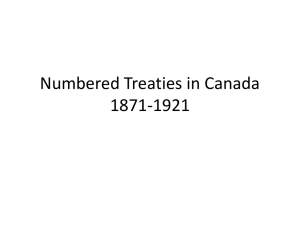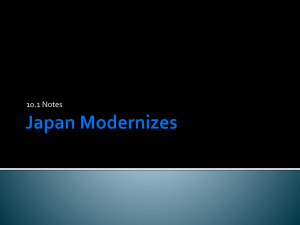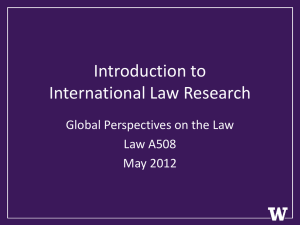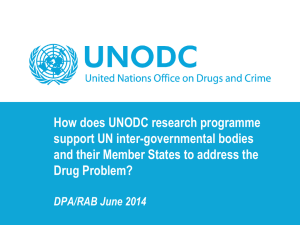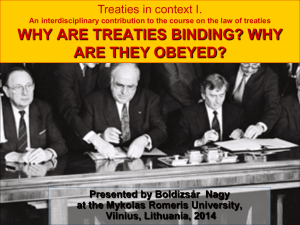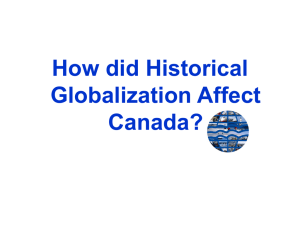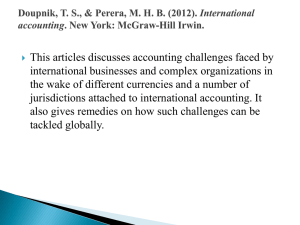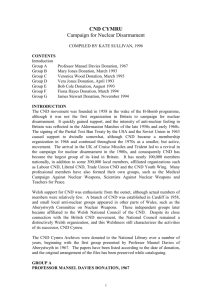Harm Reduction and the International Drug Control System
advertisement
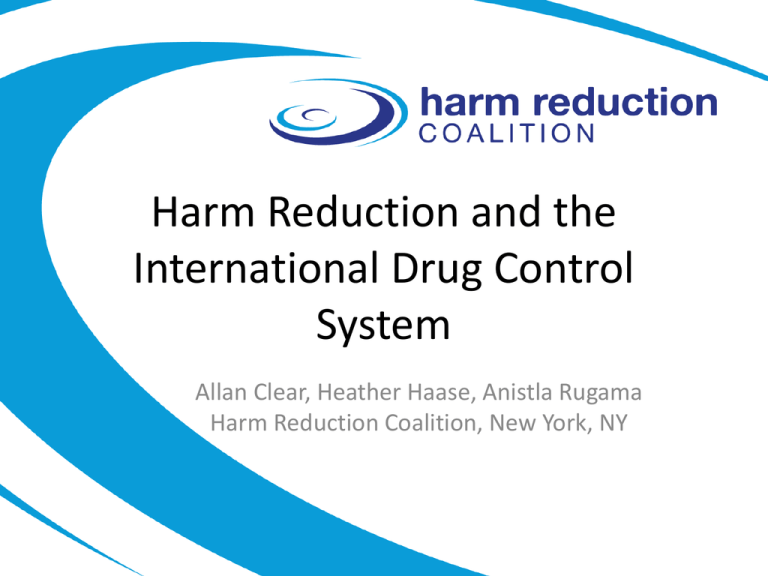
Harm Reduction and the International Drug Control System Allan Clear, Heather Haase, Anistla Rugama Harm Reduction Coalition, New York, NY Harm Reduction and the International Drug Control System International Drug Control System •Has its history in the 1912 Hague Opium Convention and the treaties negotiated after that in the League of Nations era •System was initially intended to control the flow of licit medicines but grew to include prohibiting the “illicit” use of substances •Current global drug control system is administered under the United Nations under three international drug control treaties What is an international treaty? Agreement Multilateral or bilateral Self-executing vs. non-selfexecuting Interpretation and Binding effect Three International drug law treaties 1961 Convention on Narcotic Drugs (as amended by the 1972 Protocol) 1971 Convention on Psychotropic Substances 1988 Convention against Illicit Traffic in Narcotic Drugs and Psychotropic Substances 1961 Single Convention •The “bedrock” of the international drug control system •limits the “production, manufacture, export, import, distribution of, trade in, use and possessions of” opiates, cannabis and cocaine to “medicinal and scientific purposes” •established the International Narcotics Control Board (the “INCB”) as watchdog to monitor compliance •Established the scheduling system 1971 Single Convention on Psychotropic Substances enacted in response to drug use in the 60s added certain synthetic, prescription, and hallucinogens (LSD) to the list of scheduled substances 1988 Convention Against Illicit Trafficking •adopted in response to the increase in drug trafficking •required member countries, for the first time, to criminalize possession for personal consumption, but does not specify enforcement or punishment measures •specifically states that its implementation should be accompanied by prudence and is subject to the “constitutional principles and basic concepts of [each countries’] legal system” Purpose of the treaties •Concern for the “health and welfare of mankind” in preamble •Dual purpose of the treaties is to reduce the availability of drugs for illicit use, while ensuring adequate availability for medical use •Over time, this balance became distorted as the system evolved based on the principle that reducing availability of drugs for illicit use could only be achieved through penal enforcement of predominantly prohibition-oriented measures The international drug treaties, cont. Who are the member countries (signatories) to the treaties? Are the treaties enforceable? Why do countries adhere to the treaties (and what are the consequences if they don’t)? What some people think of the treaties… Criticisms of the treaties • Deaths from violence associated with trafficking • High incarceration rates • Human rights abuses • Lack of health care or intervention measures (such as OD prevention) for drug users • High HIV rates through injection drug use Common Treaty Myths… What is allowed under the treaties? Allowed or “gray” area: •Non-enforcement (Netherlands) •Decriminalization (Portugal) •Medicalization (Switzerland, U.S.) •Many harm reduction measures Not allowed: •Legalization for recreational use UN Resolutions What are Resolutions? • Formal Recommendations of CND to member countries • Binding vs. nonbinding • Interpretive guidance • Act as precedent • Forms “customary” law Treatment of harm reduction measures under the treaties Allowed: •Overdose prevention •Maintenance therapies (Methadone, buprenorphine and heroin prescription) •Syringe Exchange & syringe access Not allowed (according to INCB): •Safe Injection Spaces •Pill testing UN Drug Control Bodies •Commission on Narcotic Drugs (CND) –Delegates from 53 countries –meets every year to review the policies enacted under the treaties and to guide future policy –Adopts “resolutions” and “political declarations” concerning drug policy •UN Office of Drugs and Crime (UNODC) –Implements programs based on policies enacted by CND –Has its own budget for drug-related programs •Int’l Narcotics Control Board (INCB) –Acts as “guardian” or “watchdog” of the treaties –Issues reports on various countries’ compliance (e.g., safe injection sites, “drug tourism” and medical marijuana) What is CND? The Commission on Narcotic Drugs is the central drug policy-making body within the United Nations system, with important functions under the three international drug law treaties. What is CND? “CND” also refers to the yearly meeting held in Vienna each year •attended by large group of NGOs and governmental delegates •network, exchange information •influence international law and policy •learn about the UN system and keep up with developments under the treaties Who Attends CND? Government delegations NGOs from around the world What do governmental delegates do at CND? • Introduce resolutions to the CND • Participate in formal policy discussions in session • Side events • Debate resolutions behind closed doors • Argue resolutions on the floor • Diplomacy/alliances What do NGOs do at CND? • • • • • Influence delegates “in the hallways” Put on side events on various topics Distribute literature Participate in roundtable discussions Ask public questions during “informal dialogue” sessions • Observe proceedings and report back home through social media, reports, articles, etc. Drug Lords Celebrate the Drug War at the UN http://drogriporter.hu/en/celebrate What happens at CND? Opening session Statements from leaders Statements from governmental delegations Formal Sessions- Plenary and the CoW Debate and adopt resolutions Roundtable discussions Informal sessions -- “side events” Gearing up for opening sessions Yury Fedotov, Executive Director of UNODC Evo Morales’ line of coca leaf products Side events • Presented by NGOs and governments • Usually discuss some current aspect of drug policy last year OD prevention, Count the Costs, Bolivian coca leaf This year Global Commission on Drug Policy, Latin America, 100 Year Anniversary of the 1912 Hague Opium Convention, Future of the International Conventions • Informal “dialogue” with heads of INCB, UNODC and CND Informal Dialogue with former INCB President Hamid Ghodse How to create change? Reform of the current system • Modification/amendment • Denunciation/disregard • Withdraw and re-accede with reservation Reform within the current system • Influence delegations • Push for broader interpretation • Introduce/promote/support UN Resolutions Examples of Recent Progress made in Harm Reduction through Resolutions at CND • HIV resolutions • Political Declaration 2009 • Civil Society Resolution 2011 • Overdose Resolution 2012 Revised Draft Political Declaration Civil Society Resolution Resolution 54/11 – Improving the participatory role of civil society in addressing the world drug problem •Encourages Member States to ensure that civil society plays a participatory role, where appropriate, through consultation, in the development and implementation of drug control programmes and policies, in particular with regard to aspects of demand reduction; •Also encourages Member States to cultivate an environment that promotes innovation and to take into account promising approaches taken by civil society to assist Governments in their efforts to address the world drug problem, •Further encourages Member States to provide to the United Nations Office on Drugs and Crime, in the context of the fifty-fifth session of the Commission on Narcotic Drugs, their experiences in working with civil society in United Nations forums and to provide suggestions … with a view to improving the participatory role of civil society in addressing the world drug problem, Overdose Resolution •Major victory for harm reduction at CND •OD resolution –Encourages member states to effective elements for the prevention and treatment of drug overdose in national drug policies –Requests UNODC and WHO to collect and circulate best practices including the use of naloxone, to provide member states with guidance, and to include initiatives on OD prevention as part of their drug demand reduction programming –Invites member states and donors to provide funding •Process of passing a resolution What does all this mean for Int’l and U.S. Reform? •Political Declaration: created a dialogue about harm reduction and ultimately opened the door for reform •Resolution 54/11: Civil society will have more opportunities to influence the UNODC, INCB and delegates at CND at the international level •Resolution 55/7 OD Prevention: –UNODC can now fund OD programs throughout the world –Member states will have official guidance on OD prevention, especially Naloxone –The White House ONDCP’s changed attitude towards overdose measures including Naloxone can result in more acceptance (and funding) for domestic programs What can you do? Attend CND if you can • Develop a presence • Network/collaborate with international organizations • Influence delegations behind the scenes • Distribute literature • Report back home From home • Follow CND through social media • Learn about the UN process and write about it • Reach out to international organizations For more information For more information on the international drug control system: http://harmreduction.org/our-work/policyadvocacy/international/ For podcasts about CND 2012: http://harmreduction.org/our-resources/multimediaresources/podcast-archives/ For information on overdose prevention: http://harmreduction.org/issues/overdose-prevention Allan Clear Clear@harmreduction.org Heather Haase hhaase@msn.com Anistla Rugama rugama@harmreduction.org


